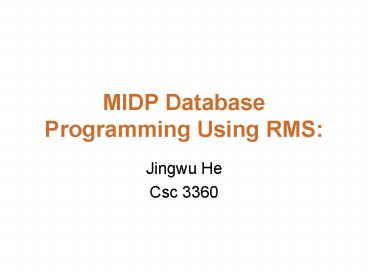MIDP Database Programming Using RMS: - PowerPoint PPT Presentation
1 / 10
Title:
MIDP Database Programming Using RMS:
Description:
Persistent storage is a non-volatile place for storing the state ... The MIDP provides a mechanism for MIDlets to persistently store data and retrieve it later. ... – PowerPoint PPT presentation
Number of Views:74
Avg rating:3.0/5.0
Title: MIDP Database Programming Using RMS:
1
MIDP Database Programming Using RMS
- Jingwu He
- Csc 3360
2
Persistent storage
- Persistent storage is a non-volatile place for
storing the state of objects. - . If you save objects to persistent storage,
their lifetime is longer than the program that
created them, and later you can read their state
and continue to work with them. - MIDP Record Management System (RMS), a persistent
storage for MIDlets, develops MIDP database
applications.
3
Introducing the RMS
- The MIDP provides a mechanism for MIDlets to
persistently store data and retrieve it later. - This mechanism is a simple record-oriented
database called the Record Management System
(RMS). - A MIDP database (or a record store) consists of a
collection of records that remain persistent
after the MIDlet exits. When you invoke the
MIDlet again, it can retrieve data from the
persistent record store.
To use the RMS, import the javax.microedition.rms
package
4
Opening a Record Store
To open a record store, use the openRecordStore()
static method RecordStore db
RecordStore.openRecordStore("myDBfile",
true) The above code creates a new database
file named myDBfile. The second parameter, which
is set to true, says that if the record store
does not exist, create it.
5
Creating a New Record
A record is an array of bytes. You can use the
DataInputStream, DataOutputStream,
ByteArrayInputStream, and ByteArrayOutputStream
classes to pack and unpack data types into and
out of the byte arrays. The first record created
has an ID of 1 and is the primary key. The second
record has the previous ID 1. Now suppose you
have the following string record FirstName,
LastName, Age. To add this record to the record
store, use the addRecord() method as follows
ByteArrayOutputStream baos new
ByteArrayOutputStream() DataOutputStream dos
new DataOutputStream(baos) dos.writeUTF(record)b
yte b baos.toByteArray() db.addRecord(b, 0,
b.length)
6
Reading Data from the Record Store
To read a record from the record store, you
construct input streams instead of output
streams. This is done as follows
ByteArrayInputStream bais newByteArrayInputStrea
m(record1) DataInputStream dis
newDataInputStream(bais) String in
dis.readUTF()
7
Deleting a Record from the Record Store
To delete a record from the record store, you
have to know the record ID for the record to be
deleted. To delete the record, use the
deleteRecord() method. This method takes an
integer as a parameter, which is the record ID of
the record to be deleted. There is no method to
get the record ID. To work around this, every
time you create a new record, add its record ID
to a vector like this
Vector recordIDs new Vector() int lastID
1 //Add a record....parameters are missing
here db.addRecord() // Now add the ID to the
vector recordIDs.addElement(new
Integer(lastID))
8
Deleting a Record from the Record Store
Now, to delete a record, find the record ID of
the record you want to delete
Enumeration IDs recordIDs.elements() while(IDs.
hasMoreElements()) int id ((Integer)
IDs.nextElement()).intValue() //Compare to
see if this is the record you want by
//invoking compare() which is shown next.
//Then call db.deleteRecord(id)
9
Comparing my Record with Records in the Record
Store
To search for the right record to delete, your
application must implement the Comparator
interface (by providing an implementation to the
compare method) to compare two records. The
return value indicates the ordering of the two
records. For example, suppose you want to compare
two strings that you retrieved from two records.
Here is a sample implementation
public someClass implements Comparator public
int compare(byte record1, byte
record2) ByteArrayInputStream bais1 new
ByteArrayInputStream(record1)
DataInputStream dis1 new DataInputStream(bais
1) ByteArrayInputStream bais2 new
ByteArrayInputStream(record2)
DataInputStream dis2 new DataInputStream(bais
2) String name1 dis1.readUTF()
String name2 dis.readUTF() int num
name1.compareTo(name2) if (num gt 0)
return RecordComparator.FOLLOWS else if
(num lt 0) return recordcomparator.precedes
else return recordcomparator.equiv
alent
10
Closing the Record Store
To close the record store, use the
closeRecordStore() method.

